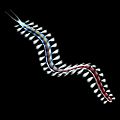Annelid facts for kids
Quick facts for kids AnnelidsTemporal range: Cambrian – Recent
|
|
|---|---|
 |
|
| Glycera sp. | |
| Scientific classification | |
| Kingdom: | |
| Superphylum: | |
| Phylum: |
Annelida
Lamarck, 1809
|
| Classes and subclasses | |
|
Class Polychaeta (paraphyletic?) |
|
Annelids are a group of animals often called segmented worms. You might know some annelids already, like earthworms and leeches! These amazing creatures live in many wet places around the world.
Some annelids live with other organisms. If they are parasitic, they live on or inside another animal and get food from it. If they are mutualistic, they live with another animal in a way that helps both of them.
Annelids come in many sizes. Some are tiny, less than a millimeter long. Others are huge, like the seep tube worm (Lamellibrachia lymnesi), which can grow up to 3 meters (about 10 feet) long! This giant worm is related to the famous giant tube worm.
Annelids have bodies made of many small parts called segments. Each segment has one or more rings. These rings are called annuli, which means 'little rings'. Annelids can regrow parts of their body if they get cut off. They have a special kind of skeleton that uses water pressure, called a hydrostatic skeleton. They also have a digestive system that goes one way, from mouth to end. Their bodies are bilaterally symmetrical, meaning they can be divided into two matching halves.
How Annelids Sense the World
Annelid worms have a special system for sensing their surroundings. This is called their nervous system. Their brain is shaped like a ring around their pharynx (which is like their throat). This brain has two main parts, called ganglia, that are connected by nerve cords.
In some very active annelids, like certain polychaetes, the brain is bigger and more complex. It can even have different sections, like a front, middle, and back part.
The rest of their nervous system runs along the bottom of their body. It looks a bit like a ladder! In each body segment, there are more pairs of ganglia. These are connected by nerves that spread out into the body wall. This helps the annelid control its movements and feel things all over its body.
Main Types of Annelids
There are three main groups of annelids. Each group has its own special features.
- Polychaetes: There are about 12,000 different kinds of polychaetes. Most of them live freely in the ocean. They often have many bristles on their bodies.
- Clitellates: This group includes about 5,000 species.
- Oligochaetes: This group includes common earthworms. They usually have fewer bristles than polychaetes.
- Hirudinea: These are the leeches. Many leeches live in freshwater and are known for feeding on blood.
- Echiura: These are sometimes called "spoon worms" because of their unique shape.
Images for kids
-
Lamellibrachian tube worms have no gut and gain nutrients from chemoautotrophic bacteria living inside them.
-
This sabellid tubeworm is budding.
See also
 In Spanish: Annelida para niños
In Spanish: Annelida para niños




